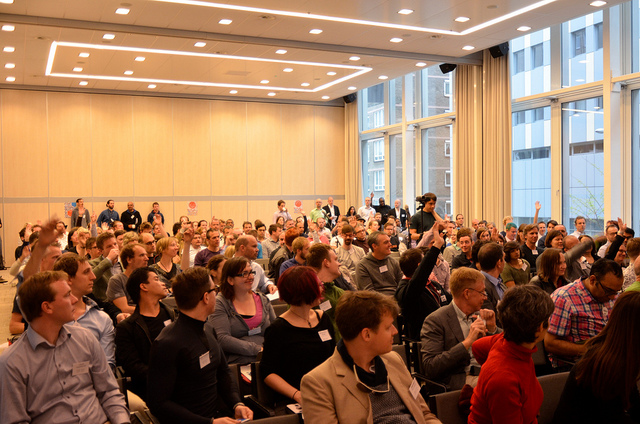
I’ve spent the last span of days trying to figure out what I want to say (first) about Quantified Self Europe 2013 (#qseu13), which took place in Amsterdam on 11 and 12 May. The conference spanned a truly amazing pair of days, both of which I spent furiously live-tweeting and paper-scribbling field notes as my jet-lagged brain threatened simultaneously to implode and to explode (in the best of all possible ways) on both an intellectual and a personal level. The Twitter-length post is easy: “Wow, #qseu13 was so awesome!” A few chapter-length essays would be easy as well, given enough time. A blog post, though…blog-length is hard.
For the sake of continuity, I’ll start this first post by picking up where I left off last week. On the first day of this year’s Quantified Self Europe, I hosted a breakout session [pdf] called, “The Missing Trackers,” in which I posed questions about who might be missing from the Quantified Self community, what we might learn about the Quantified Self community by looking at who’s missing from it, and whether those absences might be a problem. Certainly there is a range of fairly obvious (and even banal) reasons that most people are not part of Quantified Self: perhaps they are not doing any self-tracking, or are not even interested in self-tracking; perhaps they do not think about their self-tracking as “self-tracking” per se; perhaps they have no desire to discuss their self-tracking practices with other people, or with people they don’t already know; perhaps they have simply never heard of this thing called “Quantified Self.” But do any of these absences say anything about Quantified Self itself?
My own thinking, however, was running along more Bourdieusian lines: Who might be eager to discuss their self-tracking experiences with other self-trackers, yet not feel welcome within the social milieu of Quantified Self? My goal was to lead the group toward a discussion of how some people might not feel comfortable in the Quantified Self community not because of any overt discrimination on the part of Quantified Self, but because their race, gender, social class, level of (formal) education, amount of income, comfort with new technologies, or general lifestyle marked them as different from the majority of other Quantified Self community members. At the macro level, Quantified Self likes to think of itself as being welcoming to newcomers, so I hoped to ask my session what current community members might do to be more welcoming of interested self-trackers who might have different levels of cultural capital [pdf].
This is not exactly the discussion that happened, however. While some session participants readily linked my questions to long-standing problems of race- and gender inclusivity within tech culture generally, others were unwilling (or unable) to push past examining the question of “Who’s not a part of Quantified Self” at the individual level. This group in particular remained focused on the non-trackers, and the reasons they offered for the non-trackers’ absences were largely matters of individual preference or personality (things which are more “social” than “individual” to a sociologist, but I digress). In the end, shifting our focus back toward the Quantified Self community, and the level of our analysis back to social groups, was a bigger task than I could pull off in an hour.
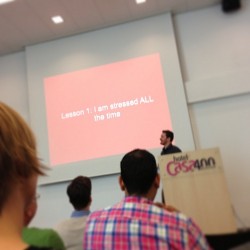
At the same time, I do think the discussion was worthwhile even though it wasn’t the discussion I’d intended. To my way of seeing it, a breakout session is a collaborative effort between the session leader and the session participants; while I saw it as my responsibility to help nurture good conversation by reigning in tangential comments and making sure there was space for everyone so inclined to speak (skills I’ll admit I’m still developing), I think clinging too rigidly to my intended outline would have been a mistake. Forcing my vision of the session onto the group also might have foreclosed one of the more interesting (to me) lines of inquiry that came up, which was basically an inversion of my original question: Who is in the Quantified Self community?
To me, the answer to this question had been self-evident: If you’re going to one of the Quantified Self Meetup groups, or coming to Quantified Self conferences, or engaged with the Quantified Self Forum as either a reader or as someone who posts, then you’re a member of (what I think of as) the Quantified Self community. Not everyone in my session was so sure, however. One man asked earnestly, “Am I a member of the community?” To me, the answer was obviously “yes”; he was taking part in my session at Quantified Self Europe, after all. But he wasn’t as certain: Quantified Self Europe was his first participation in Quantified Self and, though he was interested in self-tracking, he’d only decided to come to the conference when he saw “committed to being inclusive” on the registration page. Even though he fit the profile of an archetypal Quantified Self member in many ways, he saw himself as an outsider, and it had taken something he could read as an explicit welcome to make him feel comfortable attending. I’m embarrassed to admit it, but this possibility—that people whom I see as being clearly within “the Quantified Self community” might not see themselves as such—had actually never occurred to me; I was far more familiar with uncertain membership in the opposite direction, namely with folks who want to draw the membership lines of “Quantified Self” around any and all people doing any kind of self-tracking anywhere, whether those people have any knowledge of Quantified Self or not. (Interestingly, I see this over-attribution of membership more often from people who have nothing to do with Quantified Self than from people who have any connection to or involvement with the group.)
The question of how to define or demarcate the Quantified Self community ended up resurfacing in other sessions I attended, and in some of the conversations I had with other conference attendees as well. Who is and isn’t a part of Quantified Self, and what distinguishes those who are a part of the community from those who aren’t? Of equal importance, how have the answers to that question changed since Quantified Self began in 2007, or even since the first Quantified Self conference in San Jose in the spring of 2011? (Interestingly, one question I didn’t see taken up was that of who gets to answer the previous two questions.) One person in my session felt that “Quantified Self” is about quantitative self-tracking only, and was frustrated both by talk of narratives and sense-making and by Meetup group “Show & Tell” presentations that include anything other than data analysis; he felt that Quantified Self was losing its focus, and going too far afield. Conversely, another person in my session suggested that the term “Show & Tell” for Meetup group presentations, and perhaps even the name “Quantified Self” itself, were no longer accurate; while these terms might have been apt descriptors when the first Meetup group started in Kevin Kelly’s living room, this session attendee argued that Quantified Self has moved beyond its comparatively narrow initial focus (which he felt was a good thing).
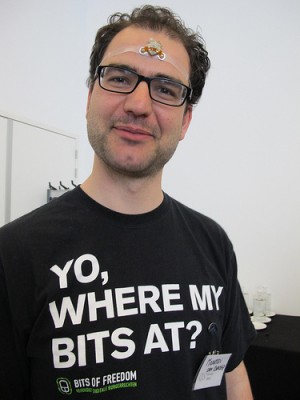
Other conversations focused on what might be considered the “grey areas” of membership within the Quantified Self community. People who market self-tracking tools they initially designed for themselves were clearly in, but what about the non-trackers who attend Quantified Self events in order to market their companies’ apps and devices to a potentially lucrative target audience? What about the doctors and insurance company representatives who attend in the hope of discovering something they can use to increase “compliance” among their patients? What about the increasing number of academics who are taking up Quantified Self as a research topic? On the one hand, Quantified Self has generally been open (even welcoming) to academics[i]; the general attitude I observed during my breakout session for academics and researchers at Quantified Self 2012 in Palo Alto last fall seemed to be, “Hey, if you want to study us, that’s cool, so long as you share your findings; if we think they’re useful, we’ll integrate them into our practices.” On the other hand, some of the attendees I spoke to at Quantified Self Europe last weekend had observed some of the academics present using the word “they” rather than “we” in reference to the Quantified Self community; another commented to me upon leaving a social-scientist led breakout session that he felt he’d been “used for someone’s research project.” Even an academic researcher who is also a self-tracker mentioned his recent observation that he code switches between “we” and “they” when talking about Quantified Self, depending on his audience.
I’ll explore my observations about the shifting culture of Quantified Self overall (and some of my thoughts about possible contributing factors) in a future post, as there’s a lot to say there. For now, I think the best answer to the question of what distinguishes the Quantified Self community from the larger group of “people who do some sort of self-tracking” came from conference attendee and presenter Robin Barooah (@rbarooah), who suggested (both in a breakout session we both attended and in conversation following) that QSers are people who are interested not only in doing self-tracking, but also in thinking about the process and practice of “tracking” itself. For example, many people might purchase a Fitbit because they are interested in tracking their physical activity; other people are interested in selling you a Fitbit. Yet only some of each camp will be interested in thinking about new and different ways to use a Fitbit, or what else a Fitbit’s counted steps might tell them about their lives, or how using a Fitbit changes their experiences of being in the world, or what it means to use a Fitbit in the first place. For some unknown portion of this latter subset group, Quantified Self has become a community and an intellectual home.
* * * * *
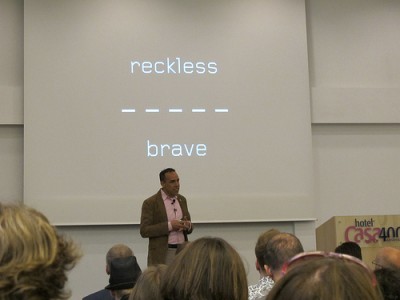
This theme of who is and isn’t part of Quantified Self also raised interesting questions for me personally. If someone had asked, I would have said that, yes, I do identify as a member of the Quantified Self community, though more because I’m present at the conferences (and some of the Meetups) and am taking part in some of the broader conversations about what it all means than because I’m doing any self-tracking myself. At the same time, “Are you tracking anything?” is a very common question at a Quantified Self event, and it’s one that has always made me feel a bit awkward. Until this weekend, I thought my awkwardness came from the fact that, no, I’m not actually tracking anything, even though “make a list of the most important mood tracking apps and use each one for at least a couple of months” has been on my to-do list for some time; I thought I felt uncomfortable because the question exposed me for being a slacker of a researcher. If this is going to be my focus area, I really ought to be self-tracking!
It hit me over the weekend, however, that I’m absolutely doing self-tracking. I may not be tracking in a highly formalized or quantitative sort of way, but I do indeed self-track, and some of my self-tracking projects have been going on for 10 or even 20 years (or longer, if you count what I could pull out of an almost-lifetime of various self-documentation practices). I have no good explanation (for instance) for why I’ve so often used the example that, “Any woman who can answer ‘First date of last menstrual period?’ is doing some kind of formal- or informal self-tracking,” without realizing that this example applies to me, too. Perhaps it’s that, since I’m not trying to conceive, the basic task of keeping tabs on my own body strikes me as unremarkably normal and not worth mentioning, whereas most of the (self-identified) self-trackers I talk to at Quantified Self events seem to have projects or specific questions or formalized procedures for recording their data. Whatever my latent conceptualization of “a self-tracking project” might be, my own practice of noting menstrual cycle patterns didn’t seem to qualify.
Yet I have other personal examples of self-tracking, too, one of which falls very clearly under the common Quantified Self theme of, “I have a chronic health problem and, in an effort to get some kind of a grip on the situation, I’m recording something about what my body does over time.” Maybe it never occurred to me that this is self-tracking because most self-tracking narratives within Quantified Self are bound up with narratives of finding or expressing agency, and I mainly note things that I experience as happening to me rather than things I experience choosing or doing. Maybe it’s because I only make notes when these things happen, rather than at regular time intervals like hours, days, or weeks; maybe it’s because my notation is mostly in words, rather than numerical values. Maybe it’s that, until comparatively recently, all this notation had neither led to any discovery nor reflected any positive change. Nonetheless, there it was staring back at me: more than a decade of my own self-tracking (albeit with a few years’ gap in the middle). Why had it never occurred to me to think of myself as a self-tracker, even after spending two years in the Quantified Self milieu?
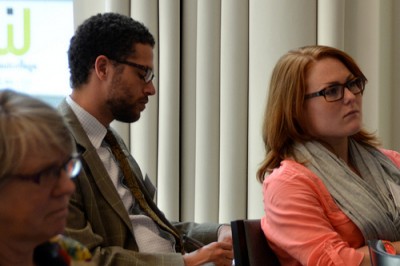
I realized, finally, that the reason “Are you tracking anything?” has made me feel awkward isn’t only because I think my answer is “no”; it’s also because, on some level, I was already aware that my answer is “yes.” As an ordinary person alone at home (or in my relationships with a few close others), I am self-tracking; as an academic and a researcher, I am not self-tracking (and I feel like that’s negligent of me). My public self may not (yet) be self-tracking, but my private self is—which means that “Are you tracking anything?” therefore represents some pretty major context collapse, all wrapped up in a commonplace and seemingly innocuous question. “Are you tracking anything?” makes me glitch less so because I don’t know whether I’m self-tracking or whether my self-tracking projects “qualify” as such, and more so because I’m not certain how much of my personal/private self I want to allow into my professional/public identity performance.
Honestly, even blatantly implying Yes, I have a menstrual cycle in a professional/public context (as I just did, above) is past my comfort level, despite the fact that this is something most people would assume about me given my gender presentation and apparent age. Though I readily claim my identity “as a woman” in professional/public spaces, and though being a woman certainly has a lot to do with embodiment (as does any gendered identity), the embodied aspects of my own identity and selfhood are things I’ve preferred to acknowledge or discuss only in more personal/private contexts. To talk about any of my existing self-tracking projects at a Quantified Self event, then, is to bring my embodiment more to the forefront of my professional/public identity—and not just my embodiment, but aspects of it that relate to my body’s biological sex (menstrual cycle) or to its vulnerabilities (chronic health problem) at that. As someone whose professional/public identity is based so heavily on what I can do with my brain, calling more attention in a professional/public context to the fact that I even have a physical body[ii] is bad enough; the idea of pointing out to people (whom I want to take me seriously!) that sometimes my body breaks, and also that it has girl parts, is really pretty scary. While I’m sure there are women who are as comfortable (or more comfortable) with calling more attention to their physical bodies in professional/public contexts as they are in personal/private contexts, right now I don’t happen to be one of them. For me, launching into a discussion of my existing self-tracking projects would basically be like coming to a conference in my underwear.
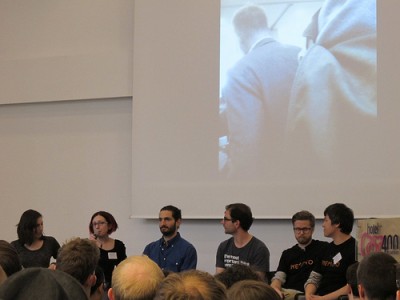
None of this should have been news to me. Last fall, for instance, I was having a conversation about gender ratios within the Quantified Self community, and I suggested that part of the reason there were fewer women than men doing Show & Tell presentations (as well as fewer women involved overall) could be that, for many marginalized groups, “visibility is a trap.” While plenty of women have given great Show & Tell talks (both at various local Meetups and at conferences), the fact that more men than women have chosen to do Show & Tell presentations is not insignificant. More recently, I even made the point that increased visibility has a greater potential negative impact for women—using myself as an example—while on a panel Saturday evening. Still, it wasn’t until I was scribbling down notes following Dorien Zandbergen (@dorienz) and Zane Kripe’s (@zanekripe) Sunday morning breakout session on “Encountering the Quantified Other” that I really put it all together with respect to myself.
As I wrote on a post-it note during an exercise in that session, “Maybe someday, when I’m brave enough, I’ll do a Show and Tell talk about what I’ve figured out.” As I’ll add now, maybe someday, when our society is more just, it will be less risky for me to do so.
Whitney Erin Boesel is usually pretty active on Twitter, though she is far more so when livetweeting a conference. You can catch the rest of her adventures over the 2013 conference season (or have occasions to use hashtag muting) by following @phenatypical.
All images from the Quantified Self Europe 2013 photo pool on Flickr.
[i] I’ll come back to this point in my future post about the shifting culture of Quantified Self overall, but it merits saying here as well: I was blown away at Quantified Self Europe by how much I felt my presence and perspective as a social scientist were respected and valued. People actually came up to thank me for things I’d said in various sessions, or to tell me that something I’d pointed out had made them see an issue in a new way. Perhaps this is normal or expected for other folks, but as far as my own range of “sociologist at tech-related conference” experiences go, it was pretty new and extraordinary—and it hints at part of what I think distinguishes Quantified Self from Silicon Valley tech culture most generally.
[ii] Not that I mean to promote the Cartesian mind/body dualism or anything (you know what I mean here, right?)

Comments 10
You, Me, Them: Who is the Quantified Self? &raq... — May 16, 2013
[...] [...]
Deborah Lupton — May 16, 2013
Hi Whitney
Great points about the gendered embodied dimensions of self-tracking in attempting to explain the gender differences in those who 'come out' as self-tracking. I was thinking of Leder's concept of the 'absent body' as I read it: he notes that this body is privileged and gendered, in that men are not positioned as 'having bodies' to the same degree as women are, and certainly as not possessing unruly bodies as women are assumed to. It is interesting that men who engage in self-tracking are bringing their bodies to the fore but perhaps doing so in order ultimately to achieve the 'absent body' again, once it has been tamed by the ordering of data. I agree that it is far more difficult in an academic/professional context to bring one's body to the fore if one is a woman (or otherwise different from the privileged white, young, male body). Robyn Longhurst has written some very interesting observations about these gendered aspects of professional embodiment.
Deborah
Elämä numeroina | Rajapinta — May 21, 2013
[...] Niitä kehitellessä on kiinnostavaa lukea hyviä blogipostauksia esimerkiksi siitä, kuka kuuluu QS-yhteisöön, missä kulkevat jäsenyyden tai osallisuuden rajat, ja ketkä puuttuvat? Äskettäin [...]
What is the Quantified Self Now? » Cyborgology — May 26, 2013
[...] (so much so, in fact, that some in the QS community now wonder if the name “Quantified Self” still describes the group accurately). In 2007, for instance, when Kelly asked, “What is the Quantified Self,” his answer stated (in [...]
The 2013 Quantified Self Europe Conference RoundupQuantified Self — May 27, 2013
[...] Missing Trackers & You, Me, Them: Who is the Quantified Self by Whitney Erin [...]
Julia Rivas — June 3, 2013
Hi Whitney,
I've just heard about the Quantified Self and as a psychotherapist I'm excited to read that people are self tracking for whatever reason. From my perspective it means that folk are getting to know themselves better albeit at an objectified (therfore not emobodied) level.
I was also interested to read your account of being a woman who menstruates and how hesitant you (we) are about bringing this very crucial aspect of our embodied experience into our wider world. Ok, because functionally it's to do with procreation (sex) there is something personal and intimate about it. However there are multitudes of women at this very moment who are struggling in their work or family life because of cramps, mood swings or heavy bleeding. Because the work place is still a predominantly male environment where the intellect is King, there is a split which denies the body ( the absent body). Therefore women have to medicate and otherwise deny their embodied experience. It's as if in order to be seen as competent and intellectual equals women have to pretend or act as if they don't have bodies that function differently to mens.
Similarly, post meonopausal women in their 50's and 60's who may be holding down very responsible jobs and be at the peaks of their careers are frequently doing so on 4-5 hrs sleep per night due to sleeplessness caused by hot flushes and night sweats. In the modern world our bodies are an inconvenience, they simply don't fit with what's expected of us. In order to be seen as credible (and to earn a living) we have to act as if we're not exhausted or medicate ourselves with HRT.
So much energy wasted trying to assume positions that deny significant aspects of our daily realities.
Puissances et limites de la mise en chiffres de soi | InternetActu — September 6, 2013
[...] mesure de soi, mais surtout ceux qui réfléchissent sur le processus et la pratique de la mesure. Comme elle l'explique dans un article pour Cyborgology : "Beaucoup de gens pourraient acheter un Fitbit parce qu'ils sont intéressés par le suivi de [...]
Return of the Quantrepreneurs » Cyborgology — September 27, 2013
[...] readers will recall that I attended QSEU13 last spring in Amsterdam, and that it was a pretty incredible experience. As QS co-founder Gary Wolf indicated [...]